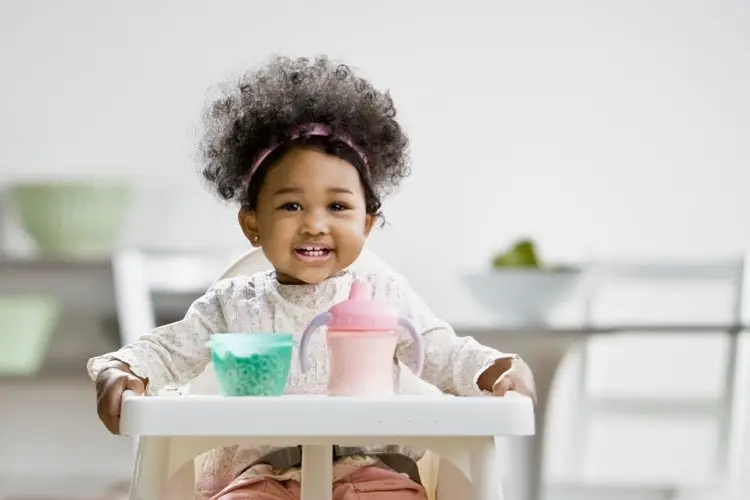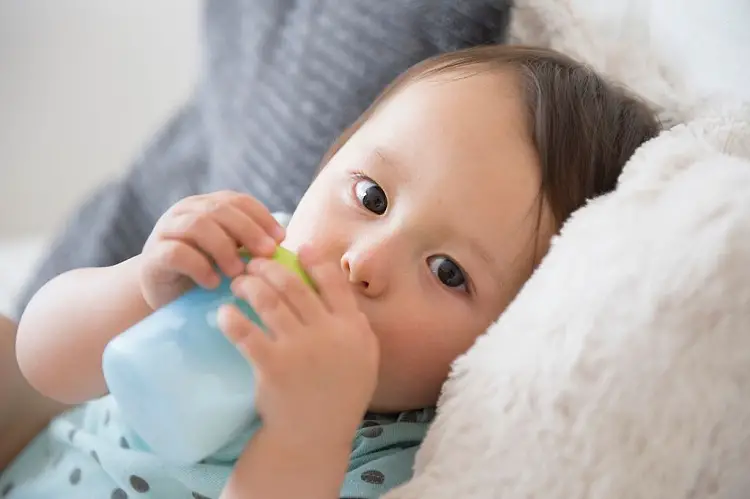Some experts believe that prolonged use of Sippy cups may interfere with proper speech development.
Sippy cups are essential and were a great invention to help minimize messes, but most times they expose the baby to habits that are quite difficult to break when you’re ready to transition to a regular cup.
In this article, we will be discussing the question “when do toddlers stop using Sippy cups”? How to transition to a regular cup from a Sippy cup and why you might want to transition sooner rather than later.
Why Should I Wean My Baby off the Sippy Cup?
According to some health experts, using a Sippy cup for a prolonged period may interfere with proper speech development and other developmental delays including.
- Sickness due to mold or mildew growth inside the spout or valve.
- Mouth injury due to falling while using a Sippy.
- Tooth decay and cavities.
- Injury to developing permanent teeth.
- Speech problems.
- Irregular development of the airway.
- Increased need for treatment in irregularities in the teeth and jaws.
- Change in looks.
- Unhealthy connection with food, developing “comfort feeding” habits.
- Child and adult obesity.
When Do Toddlers Stop Using Sippy Cups?
There’s no perfect time for a child to stop using a Sippy cup, however, most toddlers are usually able to sip from a regular cup by the age of 2.
Looking at it this way, the older the child gets, the more defiant he or she might be about giving up his Sippy cup.
According to the AAP teaching, toddlers should start drinking from regular cups between 12 and 15 months.
Once toddlers master this, you might want to use regular cups during mealtime and straw cups for water on the go.
Some health professionals advise against getting used to the Sippy-cup habit in the first place, rather they recommend introducing the open cup around 9 months while allowing your baby to take some tentative sips from the cup.
Read Also: When Do Toddlers Stop Using High Chairs
Alternatives to Sippy Cup
While the thought of quitting the Sippy Cup may sound great, the truth remains toddlers are not the most organized beings and accidents are a given.
If you’re unsure about giving up the Sippy completely, there are some other alternative products you can use instead until your baby is a little less accident-prone.
Water Bottle
If you’re worried that you’re baby isn’t drinking enough or is getting thirsty, developing a water bottle habit can be healthy, especially for later stages in life.
Always go for a water bottle you’re sure that your baby will love to use, but don’t let your baby walk around with it always, or else they will suffer mouth injury when they fall.
Rimless Cup
A rimless cup has no spout, which is one of the main causes of health and oral issues. This cup can also help educate your baby proper form of drinking from a real cup.
Straw
A straw sitting in an open cup is very easy to tip, but many straw-type Sippy cups are leak-proofed they don’t educate your child on how to be careful so they don’t spill.
A simple lid and straw could be quite helpful since they don’t pose the risk of tipping, unlike regular straws.
Read Also: How To Clean Sippy Cup Valves
How to Switch Your Baby to a Regular Cup

If you’re ready to switch your baby from a Sippy cup to a regular cup, try any of the following:
1. Make use of Rimless Sippy Cup
If you feel ready to wean your baby off his Sippy cup but you’re not mentally ready to deal with the imminent spills, use a rimless Sippy cup as a transitional tool.
The cup will help your baby get the hang of the tipping motion, as well as the placement while forming their mouth on the rim.
2. Pour a small amount of liquid into their cup
The less milk there is in a cup, the less chance for you to clean up off your floor. As your baby is still learning how to drink from a cup, you should limit the liquid to one or two inches in the bottom of the cup and refill it when needed.
As the baby develops his/her skills, then you can begin to add a little more liquid, and with time they’ll be drinking from a cup like a pro.
3. Get the baby their preferred water bottle
If your baby is used to having a sippy cup all the time, you can swap it with a water bottle to give your baby something to satisfy their thirst as needed.
Remember do not fill it with anything other than water and do not let your baby walk around with it as a comfort item, your baby may fall and injure himself when their mouth hit the spout on their way down.
4. Help them with the Cup
Thinking about it, learning how to use a cup requires the development of several cognitive abilities, such as:
- Proper mouth placement.
- Consuming and drinking without allowing water to leak out of the mouth.
- Spatial development to know the quantity of the liquid in the cup.
- Motor control to tip the cup.
- Cognitive development is to know how much to tip the cup to drink without spilling.
The key here is to help your baby at the start by holding and tipping the cup to their mouth for them, this will help them develop basic oral skills to successfully drink from their cup first.
They can understand the tipping motion better on their own after you’ve given them hints.
5. Serve only his favorite drink in an open cup
If your baby is proving difficult to give up his sippy cup, go ahead and let him use it for water. But keep the open cup for his milk. When the urge becomes higher for him to drink, he’ll start using the open cup.
6. Set a Date to Remove the Sippy Cups and Prepare Your Baby
If you’re caring for an older child who is yet to give up the sippy cup habit, enlist them in the process. Set out a firm date for transitioning from the sippy cup and remind them of it often, so they’re mentally ready for what’s about to happen.
You can try something like, “You are such a big boy, I can see you’ve known how to use a big boy cup well. As soon as you turn three, we’re going to remove all of them because you don’t need them anymore!”
How To Limit Baby Messes When Transitioning From A Sippy Cup
To limit the mess when transitioning your baby on an open cup, stay in the kitchen, and fill his cup with water rather than milk, then put a towel under the high chair.
Alternatively, put the baby in an empty bathtub or outside in an empty wading pool and let him play around with it. While doing this, keep an eye on your baby, babies can get drowned in as little as an inch or two of water.
Related Posts:
- Healthy Recipes For Picky Eaters on a Budget
- Alternatives To Brushing Toddlers Teeth
- How To Wash Baby Feeding Bottle
- When Do Babies Sit Without Support (Explained)
Take-Home
We hope this article has given in-depth discussion to answer the question of when do toddlers stop using Sippy cups.
Remember, prolonged use of sippy cups can cause your baby more than dental issues and also contribute to speech difficulties.
It’s important to use the cup wisely when once your baby begins using it to prevent these problems.
If you’re finding it difficult to transition your baby from a sippy cup to a regular, we recommend you try out any of the above tips mentioned to help you cope.
